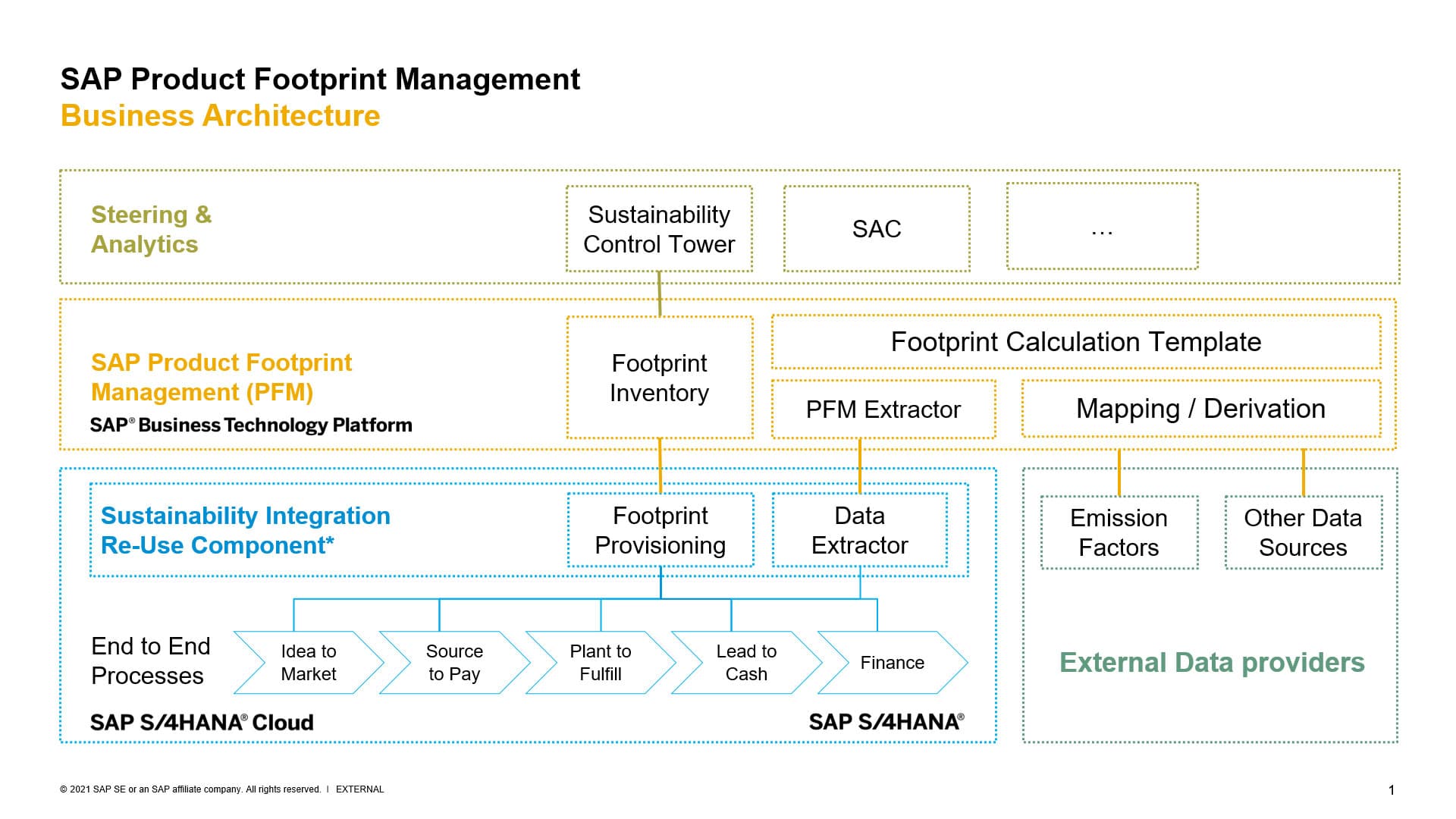With the recent launch of the SAP Product Footprint Management solution, SAP S/4HANA is uniquely positioned to create and mold a lasting positive impact for our future generations.
I grew up in Germany and can still remember when we started to separate our trash for recycling back in the 80s or 90s – our rivers and forests were suffering, and the environment was becoming a big topic. Even though we have seen progress on this front here in Germany, if you look at the global situation today, it’s clear we need to do more. It goes far beyond separating our trash. I sometimes wonder if I am part of the last generation that had the privilege to grow up in a world where natural disasters were an exception rather than the rule. Thinking about my own children, this is certainly a gut-wrenching thought.
I do not know if there is a guide through a slow-motion emergency, but the fact that climate change is already at our front door is inescapable. With the current state of the planet setting the context for us, talking about sustainability is talking about survival. It is about redefining growth, rethinking progress, and limiting financial risk. How we view our business or our industry will be a key driver in how well we proceed in creating a sustainability vision for our organization, both from within and without.
And sustainability is core to our vision at SAP. By placing sustainability at the front and center of our purpose, SAP’s strategy underlines the importance of technology, and specifically technological innovation, in enabling and accelerating climate action, hand in hand with our customers and partners.
Placing Sustainability at the Front and Center
With SAP S/4HANA Cloud, we are uniquely positioned to create a lasting, positive impact for our future generations. Leveraging SAP’s exemplary track record of managing enterprise resources for close to five decades, we want to collaborate and work closely with our customers to transition to sustainable business models. Our vision to enable customers to transform into intelligent, sustainable enterprises is based on our shared values in “chasing zero“: zero emissions (GHG), zero waste, and zero inequality.
By integrating sustainability data into end-to-end business processes across industries and value chains, we can have a significant impact and accelerate the pace of change needed. In close collaboration with our partners, customers, market makers, and standard bodies, we intend to jointly shape the future sustainability landscape that enables and drives new, redefined business process models.
The success of the SAP Sustainability Summit in April this year clearly shows that our ecosystem is ready to join forces with us, making it clear that business leaders — in addition to their top and bottom lines — also want to focus on managing their “green line” for sustainable business success. This has become the guiding principle for the way we want to evaluate and steer businesses in the future.
Embedding Sustainability Across the Entire Value Chain
SAP S/4HANA Cloud’s sustainability portfolio addresses four dimensions, including climate action, circular economy, holistic steering and reporting, and social responsibility.
Through a highly differentiated set of products, we will enable organizations to assess and reduce their carbon footprint, increase resource productivity through circular processes, and run safer, sustainable business processes while providing industry-specific insights that combine operational and financial data across value chains, embedded in core business processes.
SAP Product Footprint Management has now been released. In the next few months, we will release SAP Responsible Design and Production, already available as beta, and SAP Sustainability Control Tower, and we will deliver innovations via modular embedded SAP S/4HANA Cloud services, based on an open, flexible architecture built on top of SAP Business Technology Platform. We will continue to expand across the breadth of our SAP portfolio, bringing additional capabilities with SAP Business Network and different lines of businesses, addressing most critical use cases in different industries to enable our customers to manage their environmental, societal, and planetary impact.
SAP Product Footprint Management is an embedded SAP S/4HANA cloud-native application that enables our customers to optimize their business decisions by integrating footprint scores, preconfigured and flexible, in end-to-end business processes, periodically and at scale, considering the entire product life cycle. Our customers can gain insights by combining financial, logistic, and environmental data in analytics and can evaluate and derive footprints at scale by leveraging SAP S/4HANA Cloud data and capabilities as much as possible.
SAP Product Footprint Management is preconfigured, prescriptive, and focuses on business users (persona-based). It is based on SAP’s business data and application logic and is consistent in the calculated product footprints being integrated into the end-to-end operational processes covering all relevant business users in every department.

SAP Product Footprint Management is an answer to various challenges that our customers have encountered, whether it is the availability of emissions data to calculate product footprint across the product life cycle or the availability of calculation adhering to standards aligned to GHG Protocol ISO 14040. These indicate that high efforts are required for calculating the footprints and understanding how to use the results or the data gained from it to better optimize the way businesses are run.
Businesses agree that they need to calculate the footprint on a product level in the future, but they are unsure about how to go about it. They are still exploring different data and calculation methods. Our customers want to calculate the product footprints and then they want to analyze it — with their own tools.
To evaluate the environmental impact of the collected business data and goods movements and to be able to calculate footprints at scale, this data needs to be combined with emission factors. Ecoinvent, a not-for-profit organization, is our first partner to offer product-related emission factor datasets from its database. Building on more than 20 years of experience in lifecycle assessment methodology and around 18,000 datasets covering global supply chains, the ecoinvent emission factor datasets can be, with a license, easily imported into SAP Product Footprint Management.
In the future, we plan to enable other content providers as well so that our customers can use every provider whose data is standardized as per our applications.
It is important to establish a clear governance, ownership, and process for managing and reporting on carbon emissions. Clarity on governance will in turn drive the clarity on underlying data needs, as well as system requirements. Our partnership with the United Nations (UN) Global Compact and Accenture on SDG Ambition is an important component of our sustainability efforts. SDG Ambition aims to engage leaders across more than 1,000 companies in over 40 countries over the next two years and draw greater focus on making sustainability core to business strategy.
With our technologies, we will enable our customers to accelerate their journeys to achieving ambitious targets, helping them advance the integration of the UN Sustainable Development Goals (SDGs) into their core business systems, thereby systematically working toward their Business Ambition for 1.5°C.
Completing the Picture by Achieving Sustainability Multi-Dimensionally
With SAP Environment, Health, and Safety Management, we enable our customers to manage their corporate environmental footprint — air, water, waste, carbon — as well as their GHG emissions at a corporate level. SAP Product Footprint Management captures product lifecycle emissions required by Product Standards, as outlined in GHG Protocol.
To approach the challenge of climate change in a holistic manner and to expand it along further aspects, including water, energy, and land use as well as social dimensions, we need to begin at the core: SAP S/4HANA Cloud.
Having recognized and taken this major step, we plan to build on it and will expand to include and embed exchange emissions data into our line-of-business applications, including procurement, travel, and expense, to help bring a complete emissions transparency for our customers through SAP Sustainability Control Tower.
As an example, companies can gain visibility into carbon footprint data throughout a product’s supply chain, bringing the ability to take sustainable supply chain decisions based on actionable insights. Product-related carbon footprint data, such as for production, material sourcing, or transport, from SAP Product Footprint Management can be utilized in SAP Integrated Business Planning for Supply Chain.
The issue of sustainability can sometimes be overwhelming and it is easy to feel hopeless. But because it is a global, complex issue, it has risen to the forefront, not only in policy conversations about how to make a change, but also in the business consciousness. There is a real shift happening now in terms of how we view climate change and how we believe we can turn concern into action.
Businesses are well positioned to lead on innovations and technology that will help slow down their impact on the environment and recognize that business can only succeed if society thrives.
While there is no ready-made, off-the-shelf answer to the questions our next generation asks us, we simply must make sure that what we do today gets us closer to where we want to be tomorrow — because what we save also saves us.
Jan Gilg is president of SAP S/4HANA.



